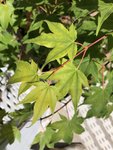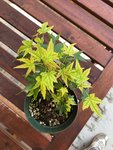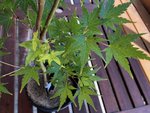@0soyoung @Bonsai Nut @River's Edge @LanceMac10 @Leo in N E Illinois @AlainK
guys i ran a test with a few cultivars. For each cultivar, I used 2 'test trees', and had many control subjects from the same parent trees, of the same size, age, substrate, sun exposure, wind, etc. All trees started out healthy and free of any symptoms.
As discussed above, my issue was exclusive to kashima, kiyo hime, and (very slightly) sango kaku. I tested these 3 cultivars, as well as deshojo, katsura, hogyoku, and yves' select
--the test trees were 'over-watered'
--the control group received my usual watering
--within one week, the over-watered specimens of all 7 cultivars developed the issue we had been discussing here (see some photos taken this weekend - my phone was full but i'll take pics of the other test trees tonight). new leaves emerged very 'cholorotic', and mature leaves developed some 'chlorosis'.
--the control group remained symptom-free
the conclusion is that over over-watering was the cause, but it isn't so straightforward because only the kashima and kiyo hime (the dwarves) were really affected. the affected specimens were in the same pot size and substrate, and exposed to the same conditions (light, wind, water, etc.) as many other trees. Therefore, it possible that I was 'over watering' all of my trees and that all cultivars were more immune to the abuse than kashima and kiyo hime, OR it is possible--and I think this is more likely given the success of my other trees--that kashima and kiyo hime must simply prefer less moisture in their substrate...
@River's Edge I think you pretty much nailed the dwarf-specific troubles in post #4 above, which took 2 months for me to figure out on my own

Thank you!
My lack of experience is on full display here!
I just wanted to thank everyone for sharing advice, experience, and knowledge with me, which offered as much--and much needed--psychological support as help with the trees! Thank you!








